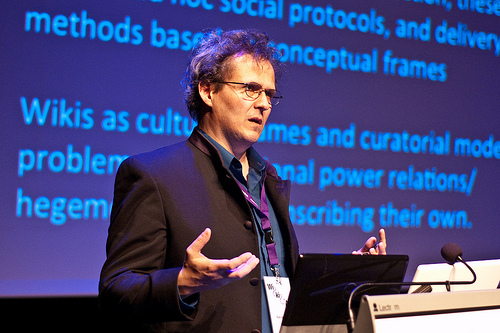On Amorphous Politics by Patrick Lichty

Since the turn of the millennium, there has been a turn toward new forms of sociopolitical dissent. These include strategies such as cellular forms or resistance like asymmetrical warfare in terms of global insurgencies, the use of social media like Twitter and Facebook to lens dissent for actions like those in Syria, Egypt and Tunisia, Wikileaks and its mirrors, and political movements that use anarchistic forms of collective action such as the Occupy. Although my focus is more concerned with the Occupy Movement, what is evident is what I call an amorphous politics of dissent. Amorphous is defined as “without shape”, and can be applied to most of the mise en scenes listed above.
The dissonance of power in regards to conventional politics can be seen in its structure. For example, the nation-state has a tiered structure of power relations. There is a President or Prime Minister, a legislative organ of MPs or Representatives, Parliaments, Houses, and the like, a judicial organ, and a Military organ. Although I am referring to US/UK forms of government, we can also argue for the hierarchical form in terms of the corporation, with its CEO, Board, Shareholders, Managers, and Workers, and even Feudal lords with their retinue of vassals and nobles and Warlords with the coteries of warriors and support personnel. The point to this is that conventional power operates roughly pyramidally with a centralized figurehead. One can argue that the pyramid may have different shapes, or angles of distribution of power, but in the end, there is usually a terminal figure of authority. To put it in terms of stereotypical Science Fiction terminology, when the alien comes to Earth the standard story is that it pops out of the spacecraft and says, “Take me to your leader.” Leadership is the conventional paradigm of power in Western culture, and dominates the industrialized world.
Territorialization refers to the exertion of power along perimeters, or borders. Functionaries expressing the constriction of territory include customs agents, border patrols, but terminally is expressed by the military wing of the nation state. This military is also generally pyramidally constructed in terms of generals, colonels, and other officers leading battalions, regiments and divisions, which are organized as defenders of a nation’s sovereignty. These military organs are conversely best optimized to exert their power against either parallel or subordinate structures. That is, parallel structures include the armies of other nations, their generals, colonels, majors, et al, and their troops and ordnance. Subordinate structures over which military powers can exert power over are the (relatively) unarmed masses that can be overrun with overwhelming power, although these forces are more specialized (National Guards and Gendarmeries). In the conventional sense, power is expressed orthogonally, whether it is against an equal or subordinate force.
Another aspect of this conversation relates to power and force through conflict as expressed by violence, but has its inconsistencies. Most of the pop cultural examples I will use later in this missive to explain amorphous action are violent in nature, but is not related to the paradigmatic jamming of conventional power. It is more related to the fact of conventional power’s orthogony, or parallelism of exertion of power. There are examples of violent and peaceful exertion of amorphous dissent as well as orthogonal conflict. In amorphous conflict or dissent, we could cite the Occupy movement as passive, and the Tunisian uprising as violent, and the Gandhi/King model of non-violent action as orthogonal/hierarchical/led, and World War Two as conventional orthogonal conflict. What is important here is the inability of conventional politics and power to cope with leaderless, non-hierarchical, non-orthogonal discourse that refuses to talk in like terms such as centralization, leadership and conventional negotiations that include concepts such as demands. This is where the site of cognitive dissonance erupts.
The need for the traditional power structure to focus identity on the antagonist in terms of figureheads is evident in the Middle East and Eurasia, but is more simply illustrated in the films Alien and Aliens, and Star Trek, The Next Generation. Both of these feature their respective antagonists, the “alien” as archetypal Other, and the Borg, symbol of autonomous, collective community. In Alien, the crew of the Nostromo encounter an alien derelict ship that has been mysteriously disabled to find a hive of eggs of alien creatures whose sole role is the creation of egg factories for further reproduction. In the Alan Dean Foster book adaptation and an extended edit of the film, Ripley finds during her escape that Captain Dallas has been captured and organically transformed into a half-human egg-layer whom she immolates with a flamethrower. However, in the Aliens sequel, the amorphous society of the self replicating aliens has been replaced by a centralized hive, dominated by a gigantic Queen that threatens to impregnated the daughter-surrogate Newt. This transformation creates a figurehead for the threat and establishes a clear protagonist/antagonist/threat relationship, and establishes traditional orthogony.
This simplification of dialectic of asymmetrical politics is also evidenced in Star Trek the Next Generation by the coming of the Borg, a collective race of cybernetic individuals. Although representations of the Borg vary as to fictional timeline, in televised media they began as a faceless hive-mind, which abducted Captain Jean-Luc Picard as a mouthpiece, not as a leader. It was inferred that if one sliced off or destroyed a percentage of a Borg ship, you did not disable it; you merely had the percentage left coming at you just as fast. However, by the movie First Contact, the Borg now possess a hierarchical command structure to their network and, more importantly, a queen. With the assimilated and reclaimed android Lieutenant Data, the crew of the Enterprise infiltrates higher level functions of the Borg Collective, effectively shutting down the subordinate elements of the Hive. In addition, the Queen/Leader is defeated, assuring traditional figurehead/hierarchy power relations rather than having to deal with the problems of the amorphous, autonomous mass. There are other “amorphous” metaphors in cinema that address the issue of amorphousness. These include the 1958 movie, The Blob, in which a giant amoeba attacks a small town and grows at it engulfs everything, The Thing, which is about a parasitic alien that doppelgangs its victims, or Invasion of the Body Snatchers that was a metaphor for the Communist threat of the Red Scare.
Perhaps one of the most asymmetric cultural forms in terms of traditional power is the involvement of Anonymous as part of the Occupy Movement. Anonymous, which has been called a “hacker group” in the mass media, is a taxonomy created on the online image sharing community 4chan.org, but has been ascribed to various factions using the term. According to The State News, “Anonymous has no leader or controlling party and relies on the collective power of its individual participants acting in such a way that the net effect benefits the group.“ The idea of Anonymous fits with the “faceless collectives” mentioned above, and certainly presents an asymmetric, if not non-orthogonal, exercise of power. Anonymous is an ad hoc voice of dissent that emerged against the Church of Scientology (see Project Chanology), where flash mobs of individuals in Guy Fawkes masks and suits arrived to protest at sites around the world. It has engaged in other activities, including hacking credit card infrastructures opposed to handling donations to Wikileaks and creating media around Occupy Wall Street. However, without a clear infrastructure and only transient figureheads, Anonymous functions as an organizing frame for a cloud of individuals interested in various collective actions, and represents an indefinite politics based on networked culture.
Another dissonance between the Occupy Movement and conventional politics is the perceived lack of agenda. This is due to its dispersion of discourse in giving its constituents collective importance in voice. What is the agenda of the disempowered 99% of Americans, or world citizens marginalized by global concentration of wealth? The agenda is for the disempowered to be heard, simply put. What does that mean? It means anything from forgivenesss of student loans to jobs to redistribution of wealth to affordable heath care, and so on. It isn’t a list, it is a call to systemic change of the means of production, distribution of wealth and empowerment in political discourse. It isn’t as simple as “We want a 5% cut in taxes for those making under $30,000.” It’s more akin to “We’re tired that there are so many sick, hungry, poor and uneducated, and we want it to end. Let’s figure it out.” It is the invitation to the beginning of a conversation that has no simple answers other than the very alteration of a paradigm of disparity that has arisen over the past 40 years through American capitalism.
The last difference the traditional power discourse is that of passive resistance. This is not a new concept, especially under the aegis of Gandhi and King conceptions. However, it is traditional power’s mere tolerance of nonviolent resistance that does not result in violence. As long as resistance does not present undue inconvenience for the circulation of power and capital, it is allowed. The irony of the technical loophole of Zucotti Park being privately owned and having few rules allowed the Occupy movement also highlights the tenuousness of public discourse in Millennial America. However, even with this oddity, on the two-month anniversary of Occupy Wall Street, force has begun to be used against the occupiers as traditional power’s patience grows thin with amorphous politics. In the streets, the marches are split up, and rules about occupation begin to be enforced with cupidity.
The new forms of politics are based on plurality, collectivism and ideas. The hierarchical nation state has no idea what to do with the amorphous blob as it grows except to try to contain it, but as with Anonymous, it is a whack-a-mole game. If one smacks down one protest, two pop up across town, or five websites pop up on the Net. Shut down Wikileaks, and a thousand mirror sites show up. People in the streets swarm New York and other cities throughout the US, and the world, and conflict arises. Asymmetry and amorphousness are dissonances to traditional power.
Ideas in themselves are not hierarchical.
Desires sometimes have no agendas.
Sometimes people want what is right, and all of it.
Patrick Lichty
voyd@voyd.com
distributed via <nettime>: no commercial use without permission
 Monday, September 3, 2012 at 09:55PM
Monday, September 3, 2012 at 09:55PM  Mapping the voyage of the Hippo.
Mapping the voyage of the Hippo. Clemens Poole + Shane Kennedy & other Hippo crew members talk story to a full Haus, Friday, August 31 at OASN1.∞
Clemens Poole + Shane Kennedy & other Hippo crew members talk story to a full Haus, Friday, August 31 at OASN1.∞


 admin |
admin |  Post a Comment |
Post a Comment |  novads,
novads,  occupational art school,
occupational art school,  update in
update in  DIY,
DIY,  collaboration,
collaboration,  collectives,
collectives,  community building,
community building,  demonstration,
demonstration,  design,
design,  discourse,
discourse,  residency,
residency,  salon,
salon,  transmissions,
transmissions,  updates,
updates,  zines
zines 














